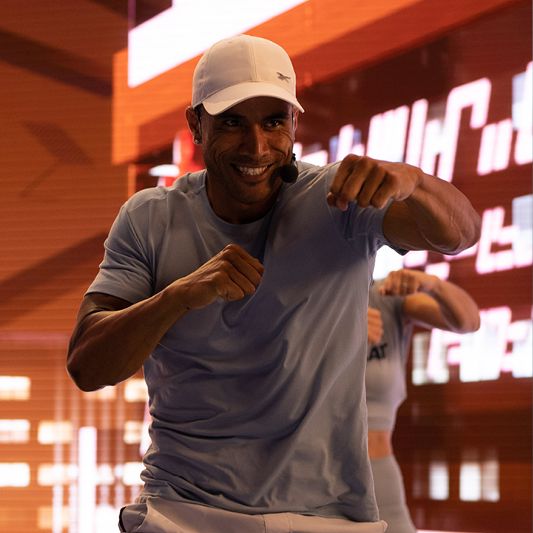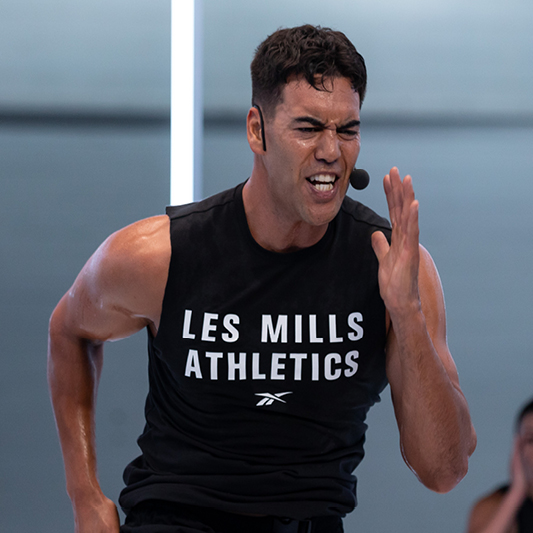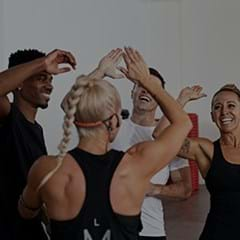I just taught three classes in a row that were really quiet and I’m not going to lie, it was pretty disheartening.
Depending on which country you’re in, Covid-19 may or may not feel like it’s in the rearview mirror. Here in New Zealand, as I write this in May 2022, we’re still feeling the pinch. Members are returning, but my lunchtime classes – which used to be banging – remain very quiet, with many in the corporate sector still working from home.
Teaching at Les Mills Auckland City, I have the privilege of watching many great Instructors teach their classes and you may be surprised to know that not every class feels like a Masterclass filming! I’ve seen the Program Directors teach to rooms that are half empty but what has always stood out to me is the energy and professionalism they bring (Lisa Osborne is the QUEEN of this!). They don’t turn down their energy for the five people who have shown up – they still give those five people a world class experience.
After teaching those three quiet classes, I decided to write this article to remind myself how to enjoy coaching fewer members. If you’ve ever taught a class that has lower numbers than you’d like, perhaps the following tips will help you too:
- Leave your ego at the door
I teach LES MILLS GRIT in the ‘Home of GRIT’ studio at Les Mills Auckland City. My GRIT Athletic was straight after Les Mills Ambassador Vili Fifita’s GRIT Strength. His class was packed. Mine had four people. It’s hard not to take that personally, and immediately I thought: “I must suck. Nobody wants to train with me. This is going to be terrible.” I felt embarrassed to be teaching to such a small number of people, especially knowing that there will be lots of other Instructors walking past and seeing how few people had shown up in my class (Khiran Huston, Joash Fahitua and Lisa Osborne all teach at that same time).
To be kinder to myself, I reminded myself that New Zealanders are early risers, and they love getting their workout done as early as possible. Also, GRIT Strength is the most popular of the three formats. Also, my GRIT Athletic only came onto the timetable four weeks ago. Also, Vili is a fantastic Instructor and he has a massive following at the club.
Fellow Ambassador Marlon Woods has his own tops tips for facing a smaller class:
“Remember why YOU do what YOU do. If numbers are low just remind yourself why you decided to teach in the first place. Some people’s why has to do with being on stage, or big numbers, or getting attention. That won’t keep you going. Dig deeper. If your why isn’t clear, use those smaller classes to connect with the people in front of you. Really try and figure out why you do what you do.
“Remember why WE do what WE do. When people get upset about low numbers, it’s because they have forgotten why we instruct. It’s not about us or our egos, it’s about the people in front of us. Remember why we do what we do. It’s for a fitter planet, not so we can brag about our class numbers.
“You never know who’s in your class. You never know what people are going through. Whether it’s one person or 100, they showed up because they wanted to be there with you. Respect their time. Show them how much you appreciate them taking the time to make themselves better.”

- The preparation is the same regardless of the number
The other reason I felt upset was that I had got up two hours early to learn the release. I’d left a friend’s birthday party early so I could wake up and prepare because I didn’t want to teach the same material I’d taught last week. When I saw the four people, part of me thought ‘I needn’t have bothered.’
You know what was cool though? One of the members came up to me at the end of the class and asked me what release we’d just done (LES MILLS GRIT Athletic 37). He said: “I was disappointed at the start when you said we didn’t need a bench, because I’d been wanting to do Athletic for ages and I wanted to use the bench. But that was such a great workout, I wasn’t disappointed at all by the end.” He asked me to do the same release next Saturday, because he’s going to bring his partner along.
Les Mills legend Dave Kyle offers the following advice: “Preparation is always the same regardless… you should always prepare to show up as your best self, be present and ready to create an inspirational experience!
“If numbers are low, this is not a reflection on you. Remember why you are there, with an opportunity to make a difference to those that do show up. The people in front of you, even if only a few, have given up their time to be with you to be inspired.
“This is an opportunity to create a more personal environment. Remember that from a participant's point of view, when they’re in the workout they might as well be on their own, the room could be empty as far as they are concerned. So long as you show the care, support and deliver a meaningful workout experience… that is why they’re there. Remember that people very rarely remember what you said, but they will never forget how you made them feel.
“Bring the energy! You need to create the energy that you want to see… pull them into your world and make their day! And be assured if you do, then word of mouth about their experience will soon have the class rocking in the future!”
- Teach with the same energy as if the class was packed
Let’s face it, it’s easy to give 100 per cent when the room is full; the energy is there before you even get moving! The challenge comes when you’ve got two people in front of you and it can be soooooo tempting to completely drop your energy and half-ass the class.
So how do the masters at Les Mills Auckland City handle this?
Program Director Dan Cohen aims to always keep his teaching at the highest standard, no matter the number in the room: “Make it a habit. This was feedback I got during a prep week for filming. For me, that means that when I teach my regular classes, I don’t fall too far from how I teach in filming Masterclass. I set a high standard for filming and I try to make it a habit, so that I’m regularly teaching at that level.”
“No matter what kind of day I’ve had, I never give anything less than a hundred and ten percent,” says Vili Fifita. “I love training with people, and it doesn’t matter the number: I would give the same energy and love to five people as I would to a thousand. I don't turn it up for 100 people and turn it down for five. I give the same amount of energy regardless who's in the room. It's about respecting those who have dedicated their time to be with you.”
Les Mills Ambassador Ben Main suggests: “If the class is really small, get off the stage and teach it on the floor with them.
“Throw the script out the door and coach to who is in front of you.
“Make extra effort to connect.
“Probably the most important one: teach with the same energy you normally would. The members still want an epic class. It’s only you facing out towards the floor and can see how many are in your class. Everyone else is facing you.”

- Focus on Connection
If Connection isn’t your forte, then smaller classes are the perfect way to refine your skills. There’s absolutely nowhere to hide when there’s only a few members in the room. This is your opportunity to learn names, get comfortable with eye contact and generally make people feel special!
“People come back to my classes because I focus a lot on connection,” says Ambassador Reagan Kang. “I focus on making people feel like they’re the only person in the room. I learn names and I try to talk to everyone in the room, to make them feel connected so that the next hour is just you, me, the music and the workout. I want them to forget everything else that’s going on in their lives so we can just focus on what we're doing. Then when they leave the class, they feel a lot better about themselves.
Fellow Ambassador Lunar Lu agrees: “I actually love to teach small number classes, as I can make more individual connections with them. I have more specific focuses for small group classes.”
- See it as an opportunity
As mentioned, my class was in the GRIT Studio at Les Mills Auckland City. There’s heaps of foot traffic through that studio because it’s right next to the cycle, Conquer and Ceremony studios, as well as being surrounded by cardio machines. In other words, there are plenty of people walking past my class who can see what’s going on.
I like this wisdom from BODYPUMP™ Instructor Eva M. Geier: “The best advice I got was teach your smallest classes the best you ever possibly could. You want those few people leaving there and talking about how great it was, which in turn can only grow it!”
When I taught that small class on Saturday, I was conscious that I was not only making an impression on those in the class itself, but also all the members walking past to other classes. I want them to see what’s going on in my slot and think ‘That looks good, maybe I’ll go to Sarah’s class next week.’
Want to grow your numbers? Check out Rachael Newsham’s tips on how to make your class stand out.








